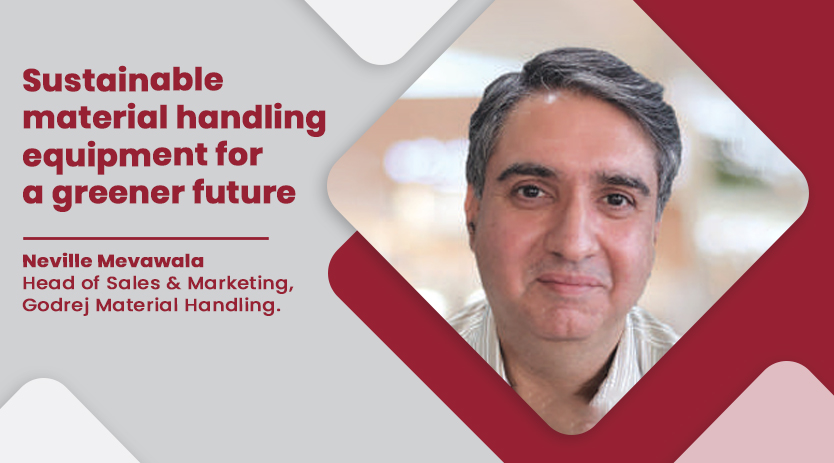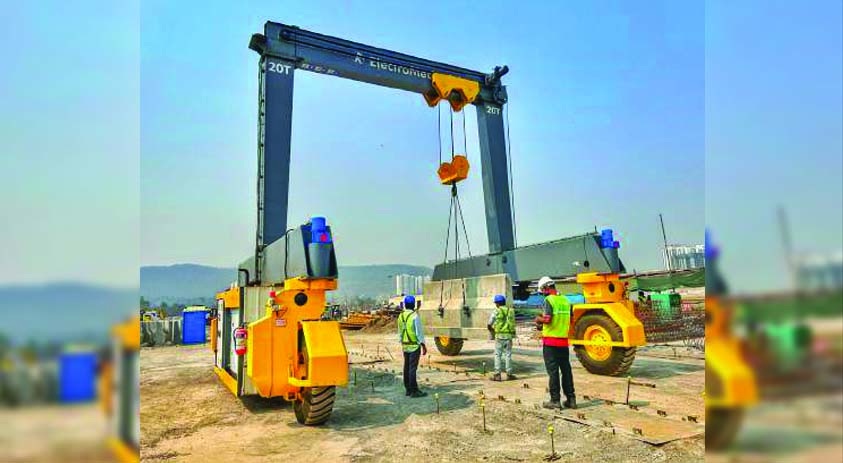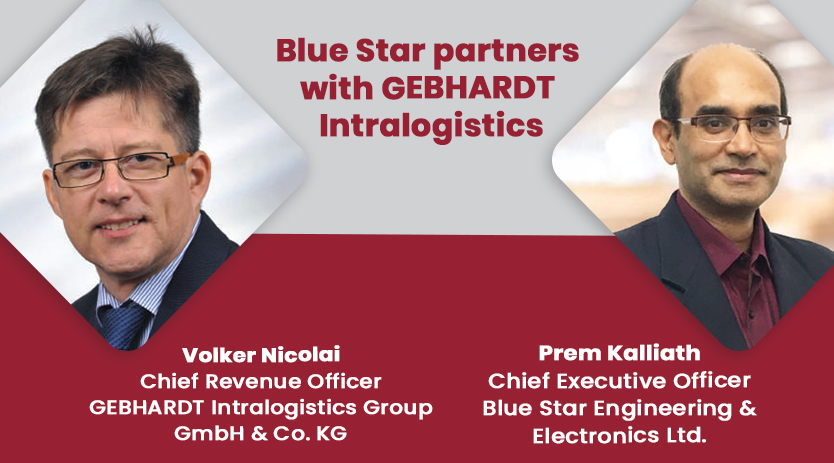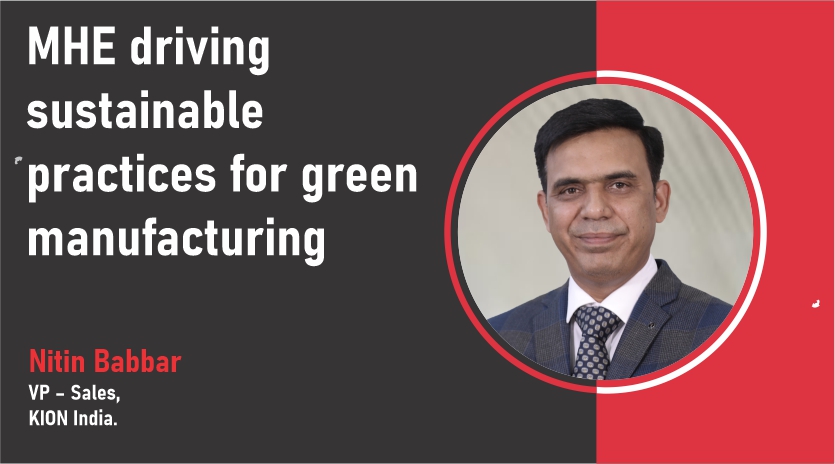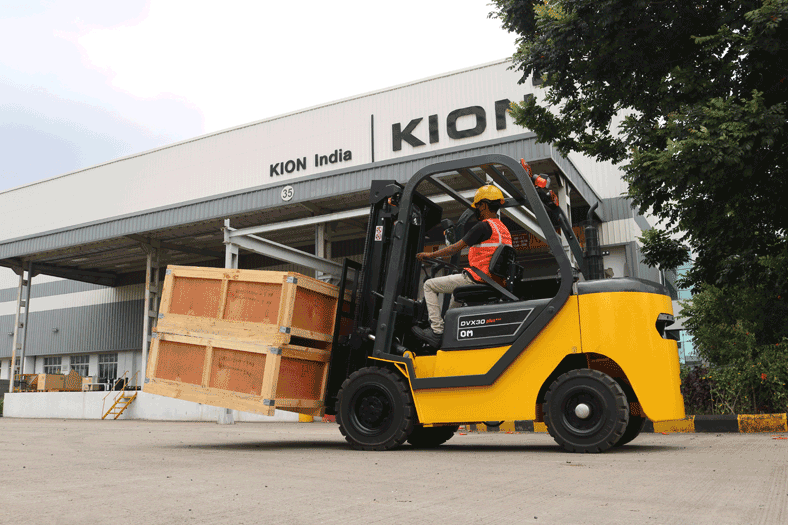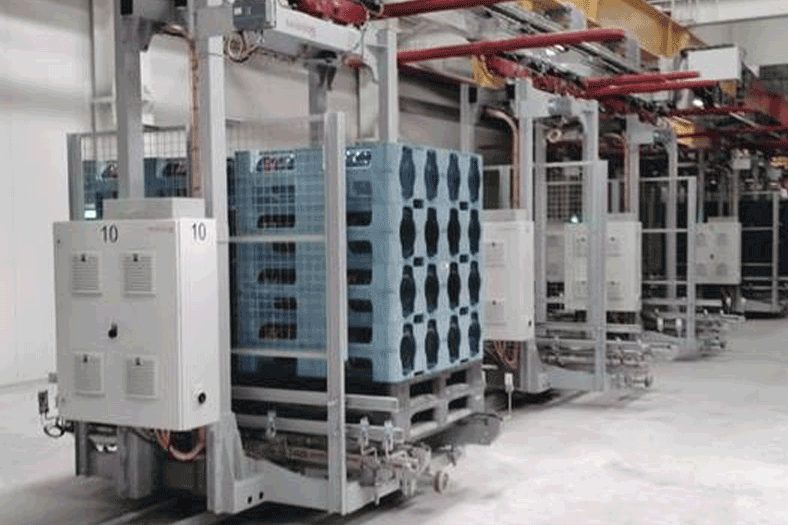Sustainable material handling equipment for a greener future
November 1, 2023 11:21 am
In a world increasingly focused on sustainability, Neville Mevawala, Head of Sales & Marketing, Godrej Material Handling, explores how Godrej Material Handling is at the forefront of eco-friendly material handling solutions. Their innovative practices and dedication to sustainability are reshaping the logistics and infrastructure industry.
Please explain how automation in MHE represents a transformative leap in efficiency.
Automation in MHE forklifts represents a transformative leap in material handling efficiency. Incorporating advanced technologies is pivotal to improving various aspects of industrial operations. AGVs, the Automated Guided Vehicles, can navigate autonomously, reducing the need for manual intervention. IoT, the Internet of Things, plays a crucial role by providing real-time data insights, enabling quick decision-making. Collaborative robotics strengthens the interaction between humans and machines, making workflows more efficient. Advanced material identification and cloud-based management of vehicle fleets also enhance precision and centralised control. The incorporation of automation increases productivity and also promotes a safer and more effective workplace.
What impact have cobots had on your logistics and warehouse operations regarding safety, efficiency, and human interaction?
Collaborative robots, or cobots, prove to be invaluable assets in the domain of material handling within logistics and warehouse operations. They offer many benefits, with a primary emphasis on enhancing safety and operational efficiency. The collaborative nature of cobots facilitates seamless interaction with human operators. It establishes a synergistic partnership that optimally leverages the strengths of both entities. This collaborative approach boosts productivity by automating repetitive tasks. It also empowers human workers to redirect their efforts toward more intricate and strategic aspects of the operation.
Cobots, or collaborative robots, are highly flexible and adaptable, essential in busy warehouses where tasks can change quickly. They can be easily programmed and reconfigured, making them excellent at handling shifts in materials or tasks, and this helps improve the overall agility of warehouse operations. Cobots are crucial for enhancing workplace ergonomics. They take on physically demanding tasks, reducing the chances of worker fatigue and injuries.
The integration of cobots into material handling processes elevates efficiency. This also establishes a safer and more ergonomic working environment. Since 2009, Godrej & Boyce has been a leader in robotics and automation. They have integrated articulated 6-axis robots into their manufacturing processes. With over 50 robots operating, these machines are used for repetitive and labour-intensive tasks. Their dedication to advancing robotics also includes exploring collaborative robots (COBOTS) in various areas, including welding, pick-and-place, and assembly.
How do you evaluate the market for MHE with infrastructure growth?
The demand for MHE is intricately linked to the pace and scale of infrastructure development. As infrastructure projects expand, there is typically a concurrent need for advanced material handling solutions to facilitate construction, transportation, and logistics. The technological landscape within the MHE sector is crucial.
The market prefers innovations like automation, integration of IoT (Internet of Things), and smart material handling solutions. These preferences align with the larger trends seen in industrial and infrastructure progress.
What role do sensors and predictive maintenance play in optimising the performance of AGVs to reduce downtime?
Sensors and predictive maintenance play crucial roles in optimising AGVs, thus significantly reducing downtime in industrial operations. AGV-embedded sensors act as the system’s eyes and ears, capturing real-time data on various operational parameters. This data is then employed for predictive maintenance, enhancing the overall reliability and efficiency of AGVs. Sensors have a wide range of applications, including proximity sensors for tasks such as navigation and obstacle detection, ensuring the safe operation of AGVs within their surroundings.
Predictive maintenance uses the sensor data gathered to predict possible problems before they become major failures. By analysing sensor data for patterns and trends, maintenance teams can spot early indications of wear, component deterioration, or potential issues. This early insight enables proactive maintenance actions, like scheduled component replacement or repairs, upon detecting early warnings, thus preventing unexpected breakdowns and minimising downtime.
Godrej Material Handling has introduced a fleet management system called SafeLog. The main goal of SafeLog is to offer customers real-time data and initial analysis, providing them with valuable insights into their Material Handling Equipment operations.
What are your predictions for the future trends in material handling equipment components?
One significant trajectory involves the integration of advanced automation and robotics technologies. Robotics, which encompasses autonomous navigation and collaborative robotics, will play a pivotal role in optimising the efficiency and flexibility of material handling processes. Sustainability is a key driver, leading to innovations in energy-efficient power systems for MHE. Future components may showcase advanced battery technologies and hybrid power solutions, aligning with environmental goals while reducing operational costs.
How does Godrej Material Handling’s commitment to sustainability and eco-friendly equipment align with the global shift towards greener solutions in the logistics and infrastructure sector?
The escalating demand for efficient and eco-friendly material handling solutions aligns with the global shift toward sustainability and environmental awareness. Sustainable material handling equipment is pivotal in diminishing carbon emissions, mitigating noise pollution, and reducing dependence on fossil fuels.
In light of government and industry efforts to reduce environmental impact, adopting sustainable equipment emerges as a cornerstone for achieving overarching sustainability objectives.
In recent years, Godrej Material Handling has concentrated on reducing carbon emissions by adopting sustainable practices, creating innovative products, using eco-friendly production methods, and contributing to national biodiversity conservation.
By integrating sustainable technologies and design concepts into our range of material handling equipment, we present solutions that minimise environmental impact. By integrating sustainable technologies and design principles into our range of material handling equipment, we present solutions that minimise environmental impact. The solutions also enhance operational efficiency—a testament to our commitment to sustainability. Our company is actively moving towards reducing its environmental impact and promoting a more sustainable future for India’s manufacturing sector, with a particular emphasis on eco-friendly forklifts. In our lineup, customers can choose from the UNO, Bravo, and NEO—three distinct models of electric forklifts offered by Godrej Material Handling.
Cookie Consent
We use cookies to personalize your experience. By continuing to visit this website you agree to our Terms & Conditions, Privacy Policy and Cookie Policy.



